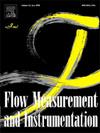A new gas slug length measurement method of slug flow in small channels based on a contactless impedance detection sensor
IF 2.7
3区 工程技术
Q2 ENGINEERING, MECHANICAL
引用次数: 0
Abstract
The gas slug length measurement of slug flow in small channels is of great importance for academic research and industrial applications. However, there exists a lack of effective methods. More research work should be undertaken. Based on a contactless impedance detection (CID) sensor, a new gas slug length measurement method of slug flow in small channels is proposed. According to many experimental results, in this work, the imaginary part of the impedance response signal is selected and its response curve (the curve) is investigated. With the curve, a feature , the ratio of the peak width at half-maximum () to the peak width at maximum () is extracted, and the gas slug length measurement model is developed. Experimental results show that the curve indeed contains valuable information of the gas slug length, and the proposed feature is effective in presenting the gas slug length. Gas slug length measurement experiments show that the proposed method in small channels is effective, and the measurement accuracy is satisfactory.
一种基于非接触阻抗检测传感器的小通道段塞流长度测量新方法
小通道段塞流的段塞长度测量对于学术研究和工业应用具有重要意义。然而,目前缺乏有效的方法。应该进行更多的研究工作。提出了一种基于非接触式阻抗检测(CID)传感器的小通道段塞流长度测量新方法。根据大量的实验结果,本文选择了阻抗响应信号的虚部,研究了其响应曲线(is曲线)。利用is曲线特征Q,提取半最大峰宽(wh)与最大峰宽(w0)之比,建立气段塞长度测量模型。实验结果表明,is曲线确实包含有价值的气塞长度信息,所提出的特征Q能够有效地表示气塞长度。气体段塞长度测量实验表明,该方法在小通道测量中是有效的,测量精度令人满意。
本文章由计算机程序翻译,如有差异,请以英文原文为准。
求助全文
约1分钟内获得全文
求助全文
来源期刊

Flow Measurement and Instrumentation
工程技术-工程:机械
CiteScore
4.30
自引率
13.60%
发文量
123
审稿时长
6 months
期刊介绍:
Flow Measurement and Instrumentation is dedicated to disseminating the latest research results on all aspects of flow measurement, in both closed conduits and open channels. The design of flow measurement systems involves a wide variety of multidisciplinary activities including modelling the flow sensor, the fluid flow and the sensor/fluid interactions through the use of computation techniques; the development of advanced transducer systems and their associated signal processing and the laboratory and field assessment of the overall system under ideal and disturbed conditions.
FMI is the essential forum for critical information exchange, and contributions are particularly encouraged in the following areas of interest:
Modelling: the application of mathematical and computational modelling to the interaction of fluid dynamics with flowmeters, including flowmeter behaviour, improved flowmeter design and installation problems. Application of CAD/CAE techniques to flowmeter modelling are eligible.
Design and development: the detailed design of the flowmeter head and/or signal processing aspects of novel flowmeters. Emphasis is given to papers identifying new sensor configurations, multisensor flow measurement systems, non-intrusive flow metering techniques and the application of microelectronic techniques in smart or intelligent systems.
Calibration techniques: including descriptions of new or existing calibration facilities and techniques, calibration data from different flowmeter types, and calibration intercomparison data from different laboratories.
Installation effect data: dealing with the effects of non-ideal flow conditions on flowmeters. Papers combining a theoretical understanding of flowmeter behaviour with experimental work are particularly welcome.
 求助内容:
求助内容: 应助结果提醒方式:
应助结果提醒方式:


